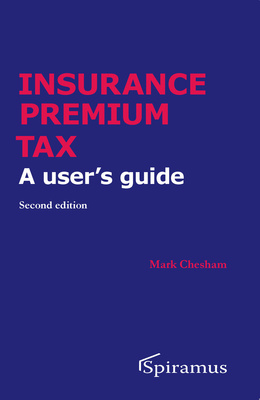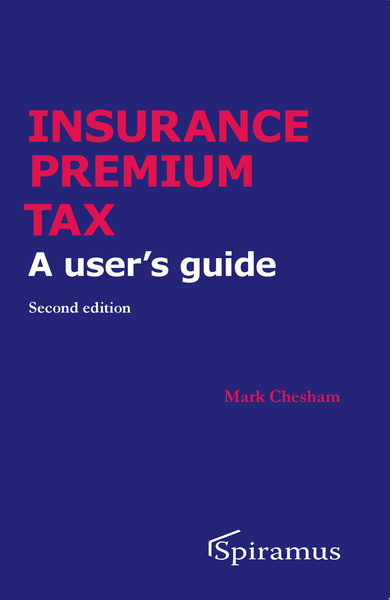Insurance Premium Tax - A user's guide
Insurance Premium Tax is a guide for practitioners and those involved in the insurance industry. It summarises how the IPT is applied in practice, the definition of an insurance contract, looks at exemptions from the tax, the application of the higher rate and issues affecting non UK risks and global policies. It also explores compliance issues such as IPT registration, the submission of returns and payment of the tax, changes in rates and the penalty regime.
- AvailablePaperback9781913507251120 pagesList Price: GBP 65.00 Add to basket
- AvailablePDF9781913507268120 pagesList Price: GBP 32.50 Add to basket
Insurance Premium Tax is a guide for practitioners and those involved in the insurance industry. It summarises how the IPT is applied in practice, the definition of an insurance contract, looks at exemptions from the tax, the application of the higher rate and issues affecting non UK risks and global policies. It also explores compliance issues such as IPT registration, the submission of returns and payment of the tax, changes in rates and the penalty regime.
The major change that has taken place since the first edition has been the UK leaving the European Union. The author explains why this does not impact greatly on IPT, though it makes the discussion on the legality of the tax otiose.
In November 2020, HMRC announced a consultation on IPT. This looked at three main areas: unregistered insurers, some ‘avoidance’ structures involving administration fees and the administration of the tax. The author reports on the consultation and HMRC reaction to industry responses.
Contents. iii
Tables of authorities. vii
1................. Introduction.. 1
Sources of information. 5
2................. What is Insurance Premium Tax. 6
2.1. Definition. 6
2.2. Is IPT legal?. 7
2.3. Insurance contracts and insurers. 9
2.4. Taxable contracts. 10
2.5. What is a premium?. 11
2.5.1. Separate contracts – commoditised insurance – Homeserve. 12
2.5.2. Net fee arrangements and broker discounts. 15
2.5.3. Retro-rated policies. 15
2.5.4. Employer’s liability insurance. 15
2.6. Coinsurance, insurance pools and fronting. 16
2.7. Warranties and guarantees. 16
2.7.1. Warranties. 16
2.7.2. Guarantees. 17
2.7.3. Mapfre. 18
2.8. Discretionary trusts. 18
2.9. Cost plus schemes. 19
2.9.1. Insurance provided cost plus schemes. 19
2.9.2. Non-insurance cost plus scheme. 19
2.10. Self insurance. 19
2.11. Voluntary excesses and deductibles. 20
3................. Higher Rate IPT. 21
3.1. Introduction. 21
3.1.1. Connected persons. 22
3.1.2. Connected parties – Protected Cell Companies. 23
3.2. Motor cars and motor cycles. 24
3.2.1. Definitions. 24
3.2.2. Types of motor insurance covered. 25
3.2.3. Ordinary motor insurance. 25
3.2.4. Guaranteed asset protection (GAP) insurance. 26
3.2.5. Other motor related insurances. 27
3.3. Domestic appliances. 27
3.3.1. Definitions. 27
3.3.2. Certain circumstances. 28
3.3.3. Guaranteed asset protection (GAP) on domestic appliances. 28
3.4. Travel insurance. 29
3.4.1. Introduction. 29
3.4.2. Definition of travel risks. 29
3.4.3. De minimis. 30
3.4.4. Travel add-ons to non-travel policies. 30
3.4.5. Corporate travel policies. 31
3.5. Higher rate insurance and free and discounted insurance. 31
3.5.1. Specified goods. 31
3.5.2. Travel insurance. 32
4................. Taxable Intermediaries. 34
4.1. Liability to register and account for IPT. 34
4.2. Criteria for a person having to register 34
4.3. Taxable intermediary provisions 35
4.4. Higher rate contracts. 36
4.5. Registration limits. 36
5................. Location of Risk. 37
5.1. Introduction. 37
5.2. Risk location rules. 37
5.2.1. Kvaerner 38
5.3. Habitual residence. 38
5.4. Business establishment 38
5.5. Unregistered vehicles. 39
5.6. Buildings. 39
5.7. Embassies. 39
5.8. Travel insurance. 39
5.9. Apportioning multi-jurisdictional risks. 40
6................. Exemptions. 43
6.1. Introduction. 43
6.2. De minimis. 43
6.3. Exemptions. 43
6.4. Non-UK risks. 45
6.5. Reinsurance. 46
6.5.1. Reinsurance of surety bonds. 46
6.6. Long-term insurance contracts. 46
6.6.1. Medical insurance, PHI and maternity cover 46
6.6.2. Long-term insurance business – relocating policyholders. 47
6.7. Commercial ships. 47
6.8. Contracts relating to the Channel Tunnel 48
6.9. Lifeboats and lifeboat equipment 49
6.10. Commercial aircraft 50
6.11. International railway rolling stock. 50
6.12. Goods in foreign or international transit 51
6.12.1. Introduction. 51
6.12.2. Definition of a container 51
6.12.3. Definition of foreign or international transit 51
6.12.4. Scope of the exemption. 52
6.12.5. Examples of insurance contracts covering goods in international transit 52
6.13. Export finance related insurance. 53
6.13.1. Introduction. 53
6.13.2. Export credit 54
6.13.3. Risks relating to financial exchange losses. 56
6.13.4. The provision of financial facilities. 57
6.14. Motability contracts. 58
6.14.1. Introduction. 58
6.14.2. Legislation. 59
6.15. Spacecraft 60
6.15.1. Introduction. 60
6.15.2. Legislation. 60
6.15.3. Definitions. 60
7................. Registration, De-registration and TOGCs. 62
7.1. Registration – introduction. 62
7.1.1. Registration – when to register 62
7.1.2. Registration – how to register 63
7.1.3. Registration – de minimis – waiver to submit returns. 63
7.1.4. Changes to registration and deregistration. 63
7.1.5. Registration – group treatment 63
7.1.6. Registration – partnerships. 64
7.1.7. Registration – overseas insurers. 65
7.1.8. Registration – Lloyd’s. 66
7.2. Deregistration. 66
7.3. Transfer of a going concern. 67
7.3.1. Introduction. 67
7.3.2. TOGC – definition. 67
7.3.3. Taking over an existing IPT registration. 68
7.3.4. TOGC – Requesting a new registration. 69
8................. Accounting for IPT. 70
8.1. Introduction. 70
8.1.1. Return periods. 70
8.1.2. Tax points. 70
8.2. IPT accounting schemes. 71
8.2.1. Special accounting scheme. 72
8.2.2. Cash receipt basis. 78
8.3. Bad debt relief 80
8.3.1. Bad debt relief – special accounting scheme. 80
8.3.2. Bad debt relief – cash receipts basis. 81
8.4. Adjusting for errors on IPT returns. 81
8.5. Changes in IPT rates. 81
8.5.1. Introduction. 81
8.5.2. Definition of terms. 82
8.5.3. Change of rate – cash receipts method. 83
8.5.4. Special accounting method. 83
8.5.5. Additional premiums (APs) and return premiums (RPs) and change of rate 84
8.5.6. Monthly written contracts. 84
8.5.7. Contracts paid in instalments. 85
8.6. Anti-forestalling provisions 85
8.6.1. Prepayments. 85
8.6.2. Contracts providing cover for more than 12 months. 85
8.6.3. Penalties. 86
8.7. Lloyd’s IPT procedures. 86
8.8. Record keeping requirements. 87
8.9. Recovering IPT paid in error 87
8.9.1. Reimbursement scheme. 88
8.9.2. Where the reimbursement scheme may not apply. 89
9................. Penalties. 90
9.1. Introduction. 90
9.2. Penalty for failure to notify. 90
9.3. Late payment of tax or rendering of returns. 90
9.4. Failure to notify a cessation of trade. 91
9.5. Failure to produce records. 91
9.6. Failure to appoint or nominate a tax representative. 91
9.7. Breach of a controlled goods agreement or walking possession agreement in Northern Ireland. 92
9.8. Liability of insured. 92
9.9. Underdeclarations. 92
9.10. Evasion of IPT. 93
9.11. Interest 93
9.12. HMRC’s stated approach to late rendering and payment penalties. 93
9.13. Security. 94
9.14. Reviews and appeals. 94
Appendix 1: HMRC Penalties for failure to notify (factsheet CC/FS11) 95
Appendix 2: HMRC Penalties for inaccuracies in returns (factsheet CC/FS7a) 103
Appendix 3: “Connected” persons. 110
Appendix 4: Forms. 112
Appendix 5: European Insurance Premium Tax (IPT) comparison table 118
Appendix 6: IPT error flowchart. 120
Index 121


